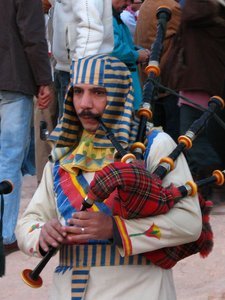Advertisement
Published: March 17th 2009

 Bagpiper
Bagpiper
Abu SimbelIt was obvious within minutes of arriving in Aswan that it was quite different to Luxor, with the hassle factor barely noticeable. It was possible to stroll through the souk without people blocking your way and trying to force you into their store. The river had more character, with a number of islands midstream and flotillas of feluccas. There wasn't the same price variation as I had experienced in Luxor. Though I was slightly perturbed to see "chicken and herpes" on my dinner menu, and there were the same quantities of policemen dotted around the place standing behind their moveable bullet-proof screens, I felt significantly more at ease here.
I had one piece of administration to deal with in Aswan, namely purchasing a ticket on the ferry to Sudan. The information on the web had been sparse and contradictory, so I will outline my experience in my next blog entry.
One of the main reasons for anyone to come to Aswan is as a base to visit the famous site of Abu Simbel, several hundred kilometres south-west on the shores of Lake Nasser. Here, Rameses II had constructed two large temples - one dedicated to the three gods Amen-Re,
Ra-Horakhty, and Ptah, as well as the deified form of himself, and one dedicated to the goddess Hathor and Rameses' favourite consort Nefertari. These temples acted as a show of Egyptian strength to the country's southern neighbours.
Originally the temples were carved out of a hillside but, in the 1960s, the construction of the Aswan High Dam and associated creation of Lake Nasser would have inundated the site. Over a four year span, a modern-day marvel of engineering was carried out, with the temples being carved up into chunks and transported to a new location out of reach of the rising waters. A fake mound was constructed to house the relocated monuments.
I had arrived in Aswan coincidentally in time for a twice-yearly festival at Abu Simbel. At the end of a corridor in the main temple are statues of the four gods to whom the temple is dedicated. On two days each year, the sun's first rays shine down this corridor, illuminating three of the statues but leaving that of Ptah, the god of the underworld, in the dark.
Due to some bizarre reasoning, travel to Abu Simbel is only possible as part of a convoy.
This is supposedly for security but one could argue it gives a nice fat tourist target to anyone wanting to get up to mischief. Normally this convoy leaves Aswan at 4AM but, on the days of these two festivals, it goes at 1AM, meaning it's not so much an early morning departure as a late night one. I have no idea how the convoy was structured, as I saw no police or army, and there seemed to be no set order as much overtaking went on.
To the disappointment of everyone, the small fold-down seats in the aisle of the minibus had been sold, and the family that had the misfortune to get on last complained long and bitterly. The drive to Abu Simbel takes a good 3.5 hours, so most people nap on the way there and back - not really possible when you have no head rest or even proper back support.
It was cold and breezy at Abu Simbel at 4:30AM, and I was glad I'd brought both my fleeces. Ticket buying was an amusing exercise in Egyptian vs Western queuing habits, and several arguments resulted. There was a great deal of waiting around, as
the sunrise didn't happen until nearly 7AM. There seemed to be various military bigwigs being shown the site, with entertainment provided for the masses by dancers, horn tooters, stick fighters, and even guys in striped
nemes headcloths playing bagpipes.
The exterior of the main temple is dominated by four large statues of Rameses II, one of which is now bodiless courtesy of an earthquake. It's not difficult to imagine how any would-be invader from the south would have felt when seeing this imperious monument.
Shortly before sunrise, the "queue" started to shuffle forward into the main temple. This was a sign for a rash of pushers-in to go about their business. The policing inside was a total joke, with flash photography and touching of surfaces being tolerated. I happened to pass the statues of the four gods just before the sun's rays hit, which caused a commotion as security was forcing everyone in front of the statues to get down on the ground. The separation of the light and dark areas wasn't quite as distinct as I'd hoped, however the interior of the temple contained a selection of carvings that I would have deemed as excellent on any

 Landscape mosaic
Landscape mosaic
Train from Luxor to Aswanday of the year.
The trip back to Aswan was hot, with the driver refusing to put on the aircon in another display of the penny-pinching that's characterised my Egyptian jaunt. As each group of passengers was dropped off at their respective accommodation, he shouted vainly "Where's my tip?" at the retreating backs.
Aswan has several other options for sightseers, including the temple of Philae, a felucca ride, and shopping, but by now I was weary of Egypt and started counting down the hours until my ferry out.
Advertisement
Tot: 0.126s; Tpl: 0.016s; cc: 11; qc: 24; dbt: 0.0711s; 1; m:domysql w:travelblog (10.17.0.13); sld: 1;
; mem: 1.1mb























